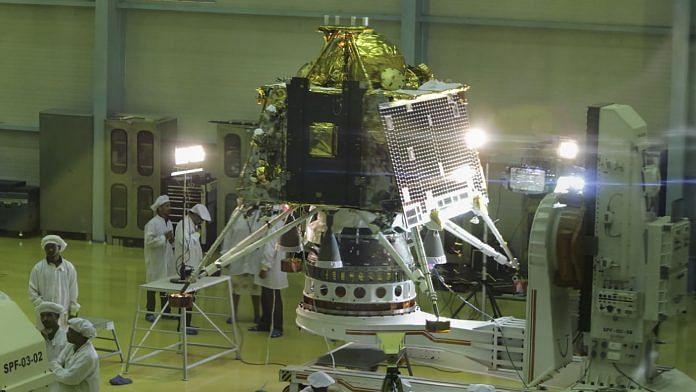Bengaluru: India’s second moon mission, Chandrayaan-2, is ISRO’s “most complex mission” so far, said the space agency Wednesday.
Unveiling the spacecraft, ISRO chairman K. Sivan said Chandrayaan-2 will be launched on 15 July at 2.15 am from the spaceport of Sriharikota, Andhra Pradesh. It will be powered by India’s biggest indigenous GSLV Mk-III rocket.
Chandrayaan-2 has three components — an orbiter, a lander, and a rover. The lander is expected to touchdown on the lunar surface by 6-7 September.
Sivan said that because the lander has to perform a soft landing and not crash on the lunar surface, it makes Chandrayaan-2 the “most complex mission” so far.
He said the spacecraft will land on a location close to the South Pole that has never been previously explored either by humans or robots. “As there is less sun in the South Pole than the North Pole, there are comparatively more ice and minerals there. The science here will be very new,” Sivan said at the ISRO headquarters in Bengaluru.
“We are moving towards a new vertical in ISRO called space science,” he added.
Stating that Chandrayaan-2 will mainly be about planetary exploration missions, Sivan said, “We are in the same position (scientist) Vikram Sarabhai was 50 years ago when he was asked why India needed a space programme. Today, we are asked why we need planetary exploration missions. It will provide scientific and technological seeds to the future generations.”
Also read: Chang’e-4 and Chandrayaan-2 — China & India missions have similar objectives, landing site
Journey to the moon
During the launch, the rover will be housed inside the lander and the whole thing will then be stacked on top of the orbiter. This entire arrangement, called the composite body, will then be accommodated inside the nose cone or payload fairing, also called ‘heat shield’, of the GSLV.
Once the orbiter enters into orbit around the moon, it will release the lander, called Vikram, after Vikram Sarabhai. Upon its successful landing, Vikram will release the rover, named Pragyan, which can move on the lunar surface for 500 metres.
The lander and rover are expected to function for 14 Earth days before frying up due to intense radiation from the sun. The orbiter is expected to function for at least a year.
The orbiter, lander and rover have eight, four and two payloads, respectively. These payloads are expected to analyse the water on the lunar surface, monitor lunar quakes, dig and study minerals and more. All the payloads are Indian, except for one American payload on the lander, operated by NASA.
The landing site is 70.9 S, 22.7 E between the Manzinus C and Simpelius N craters. This puts the lander in Earth’s direct line of sight. Thus, it will communicate directly with the ground here, as will the orbiter. The rover is expected to send data through the lander.
Profile of the mission
The launch mass of the spacecraft will be 3,877 kg. The 2.5-m-long orbiter weighs 2,379 kg, the 3.5-m-high lander weighs 1,471 kg, and the 1-m-high rover weighs 27 kg.
The lander and the orbiter each consist of 650 kg propellant to manoeuvre and push brakes while attempting to reach their destination.
Upon launch, the GSLV rocket will travel east for 15 minutes and release the spacecraft into an eccentric orbit of 178 x 38,000 km. The composite body will then perform five orbit-raising manoeuvres around Earth over the course of 16 days using the orbiter’s propellant.
When at a height of 150 x 1,41,000 km, the spacecraft will perform translunar burn and shoot towards the moon, coasting for five days and covering a distance of 3.85 lakh km.
Once it reaches near the moon, the spacecraft will fire again and perform a retro burn to brake against the lunar gravity. It will first enter an orbit of 150 x 18,000 km around the moon with an orbital period of 28 hours.
The spacecraft will then perform four orbit-lowering burns to bring itself into a 100-km circular orbit. Once in this stable orbit, the lander will separate from the orbiter and move into a 30 x 100 km orbit, where it will be parked for four days during which ISRO will perform checks on it.
On the fourth day, the lander will make a controlled descent for 17 minutes on to the lunar surface. Once it lands safely, the lander will promptly open the hatch for the rover. The rover wheels sport symbols: The Ashoka chakra on one side and ISRO’s logo on the other.
The process of landing and the subsequent release of the rover are expected to take approximately four hours, ISRO said.
Also read: What ISRO’s new spy satellite can do, and how it can penetrate clouds
Mission led by two women
Chandrayaan-2 will be India’s first planetary mission to be led by two women — the project director is design engineer Vanitha Muthayaa, and the mission director is Ritu Karidhal, who was formerly the deputy operations director of Mars Orbiter Mission.
Chandrayaan-2 incurred a cost of Rs 603 crore and involved 120 industries for its production and foreign ground station support. The GSLV rocket cost Rs 375 crore and nearly 500 industries were involved in its production.
As of now, all tests, including the final vibration and acoustic tests, are complete, said Sivan. The orbiter is expected to be transported to Sriharikota in a couple of days while the lander will be taken there on 7 July.
Sivan also unveiled the official page for the mission. The first pictures from the spacecraft are expected on 19 July.



